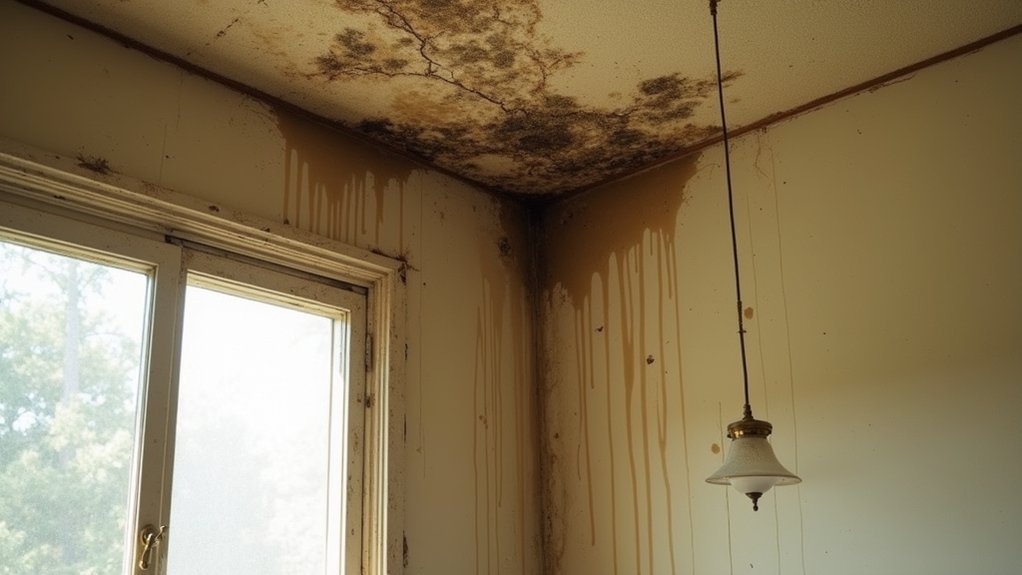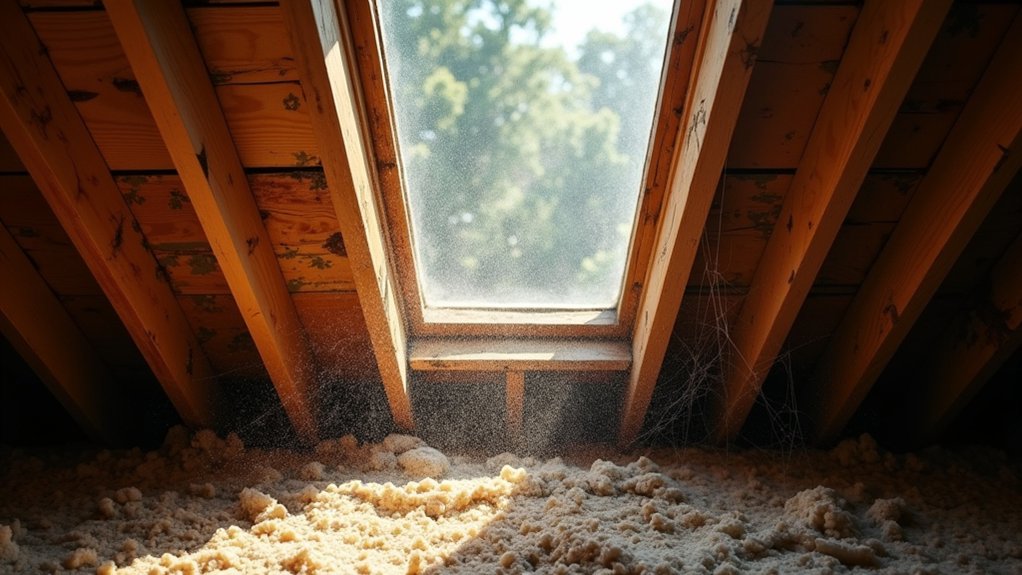You’ll need a complete roof replacement when several key indicators emerge: your roof has reached the end of its expected lifespan (20-30 years for asphalt shingles), visible deterioration appears (missing/curled shingles, granule loss), interior water damage occurs, or energy bills spike due to compromised insulation. Structural issues like a sagging roof deck require immediate professional assessment. Multiple warning signs appearing simultaneously signal it’s time for replacement. Understanding these factors will help you make an informed decision about your roof’s future.
Age and Lifespan of Your Current Roof

While most roofing materials have recommended lifespans, your roof’s actual longevity depends on several key factors including climate exposure, maintenance history, and installation quality. Asphalt shingles typically last 20-30 years, metal roofs 40-70 years, and slate up to 100 years. However, these estimates assume proper installation and maintenance.
You’ll need to examine your roof’s current age against these benchmarks. If you’re approaching the end of your material’s expected lifespan, it’s time to establish regular roof maintenance schedules. Don’t wait for visible damage schedule professional roof inspections annually to assess wear and tear. Your inspector can determine if your roof requires immediate replacement or if preventive maintenance can extend its service life. Early detection of potential issues helps you plan for replacement before critical failure occurs.
Visible Signs of Shingle Deterioration
Your shingles provide clear warning signs when they’ve reached the end of their functional life. Missing or curled shingles indicate compromised roof protection and often result from prolonged exposure to harsh weather conditions. The loss of protective granules, which appear as dark spots or bald patches on your shingles, signals deterioration of the protective layer and requires immediate professional assessment.
Missing or Curling Shingles
One of the most telling indicators that your roof needs replacement is the presence of missing, curled, or visibly deteriorated shingles. When you notice these issues, they’re often signs of advanced wear that can compromise your roof’s integrity. Missing shingles leave your roof deck exposed to moisture and weather damage, while curling shingles signal they’ve reached the end of their lifespan.
Several factors can accelerate shingle deterioration, including improper installation and inadequate ventilation. If your shingles weren’t installed correctly, they’re more likely to lift, curl, or detach during severe weather. Poor attic ventilation can trap heat and moisture, causing shingles to buckle and deteriorate prematurely. You’ll want to address these issues promptly, as damaged shingles can lead to leaks, structural damage, and costly repairs.
Widespread Granule Loss
Beyond visible shingle damage, widespread granule loss represents another major indicator of roof deterioration. When you notice dark, discolored shingles or find an abundance of granules in your gutters, it’s time to ponder a complete roof replacement. These protective granules shield your shingles from UV rays and harsh weather conditions.
As granules wear away, you’ll observe excessive shingle cracking and accelerated deterioration of your roofing materials. Your shingles will begin to look bare, patchy, or inconsistent in color. You can test for granule loss by running your hand across the shingle surface if granules easily come off or the texture feels smooth rather than gritty, your roof has likely reached the end of its functional lifespan. Don’t wait until water damage occurs to address this serious issue.
Interior Water Damage and Leaks

Interior water damage and leaks serve as critical warning signs that your roof may require complete replacement rather than simple repairs. When you notice water stains on your ceiling, mold growth in your attic, or dampness in your walls, you’re likely dealing with compromised roofing materials that have failed to protect your home’s interior.
Poor insulation maintenance often accompanies these issues, as wet insulation loses its effectiveness and can lead to increased energy costs. You’ll need to address structural integrity concerns promptly, as prolonged water exposure can weaken roof decking, compromise support beams, and damage electrical systems. If you’ve discovered multiple leak points or extensive water damage patterns, these typically indicate systemic roofing failure that spot repairs won’t adequately resolve. Consider these symptoms as urgent indicators that your roof requires professional evaluation for replacement.
Energy Bill Spikes and Poor Insulation
Your home’s monthly energy bills can spike dramatically when your roof fails to properly insulate against heat loss. During winter months, you’ll notice markedly higher heating costs as warm air escapes through deteriorating roofing materials and inadequate insulation. When you track these rising power expenses alongside other roofing issues, it’s a clear indicator that your roof’s thermal barrier is compromised and requires immediate attention.
Rising Monthly Power Costs
Rising energy costs often signal serious roofing deficiencies that demand immediate attention. When your monthly power bills consistently increase despite your weatherizing efforts, your roof may be failing to maintain proper temperature control. A compromised roof system allows heated or cooled air to escape, forcing your HVAC system to work harder and consume more energy.
- Monitor your utility bills for unexplained increases in power consumption
- Compare your energy costs to previous years during similar seasons
- Check for visible gaps between your roof and attic insulation
- Assess your attic’s temperature variations throughout the day
- Document any correlation between weather events and energy spikes
These warning signs indicate that you’ll need more than basic insulation upgrades. A complete roof replacement can restore your home’s energy efficiency and help normalize your monthly power expenses.
Heat Loss Through Roof
While proper insulation acts as your home’s thermal barrier, significant heat loss through the roof can quickly nullify its effectiveness. When your thermal insulation quality deteriorates, up to 25% of your home’s heat escapes through the roof structure, forcing your HVAC system to work harder and consume more energy.
You’ll notice this inefficiency through uneven temperatures across rooms and persistent cold spots near your ceiling. Poor roof ventilation efficiency compounds the problem by creating condensation, which further degrades insulation performance. If you’re experiencing these issues alongside increasing energy bills, your roof may be failing to maintain its thermal protection. Consider having a professional assess your roof’s insulation levels and ventilation systems to determine if a complete replacement is necessary to restore your home’s energy efficiency.
Sagging Roof Deck or Support Structure

A sagging roof deck often indicates serious structural problems that require immediate professional assessment. When you notice dips, waves, or visible depressions in your roofline, you’re likely dealing with structural integrity concerns that can compromise your entire home’s safety. These roof framing issues typically worsen over time and may lead to catastrophic failure if left unaddressed.
- Visible sagging between roof trusses or rafters indicates weakened support members
- Water damage and rot in load-bearing components can accelerate structural deterioration
- Improper initial construction or undersized framing materials may cause gradual deformation
- Heavy snow loads or excessive roof material weight can overwhelm existing support structures
- Foundation settling or wall movement might transfer stress to roof components, causing deflection
Don’t wait to address these warning signs they’re clear indicators that you’ll need a complete roof replacement.
Moss Growth and Organic Buildup
Persistent moss growth and organic debris accumulation on your roof’s surface signal more than just an aesthetic issue – they’re actively destroying your shingles and underlying structures. When moss takes hold, it creates a continuous moisture trap that deteriorates your roofing materials and compromises their protective capabilities.
You’ll notice moss typically thrives in shaded areas where excessive moisture levels persist, often exacerbated by poor ventilation in your attic space. The organic matter retains water, which can freeze and thaw repeatedly, causing your shingles to crack and separate. If you’ve discovered widespread moss coverage that’s penetrated beyond the surface layer, you’re likely facing significant structural damage. At this point, spot treatments won’t suffice you’ll need to contemplate a complete roof replacement to prevent further deterioration and potential water damage.
Storm and Weather-Related Damage
Beyond organic threats, severe weather events can inflict immediate and catastrophic damage to your roof’s integrity. When your roof faces increased wind loads and frequent hail events, structural compromise becomes a serious concern that often necessitates complete replacement.
Severe weather poses an immediate threat to your roof, with high winds and hail potentially causing irreparable structural damage requiring total replacement.
- Missing or torn shingles from severe wind exposure, creating vulnerable areas for water infiltration
- Impact damage from hailstorms that cracks or dislodges protective granules from shingles
- Lightning strikes that can split wooden support structures and create fire hazards
- Heavy snow accumulation causing excessive weight stress on aging roof systems
- Storm-driven debris impacts that puncture roofing materials and underlying decking
You’ll need immediate professional assessment after severe weather events to determine if isolated repairs will suffice or if the cumulative damage warrants a full replacement to restore your roof’s protective capabilities.
Cost Comparison: Repairs vs. Replacement
When facing significant roof damage, homeowners must carefully weigh the financial implications of repeated repairs versus a complete replacement. While repairs may seem more affordable initially, multiple fixes can accumulate substantial costs over time, often exceeding the price of a new roof.
You’ll need to consider both material quality and installation quality when calculating long-term expenses. A complete replacement typically offers better value, as it includes extensive warranties, updated materials, and uniform protection across your entire roof. Modern materials often provide enhanced durability and energy efficiency, reducing future maintenance costs and utility bills.
If your repair costs would exceed 30% of replacement expenses, or if you’re dealing with recurring issues, replacement is usually the more cost-effective solution. This investment also increases your home’s resale value and prevents potential structural damage from persistent leaks.
Choosing the Right Time of Year
The ideal timing for your roof replacement project can substantially impact both cost and quality of installation. While roofing contractors work year-round, you’ll want to contemplate scheduling during suitable weather conditions to guarantee the best results. Late spring through early fall typically represents prime installation season, when temperatures and conditions favor proper shingle adhesion.
Scheduling your roof replacement during optimal weather conditions ensures proper installation and can lead to significant cost savings in the long run.
- Schedule during moderate temperatures (50-85°F) for fitting material handling and curing
- Book your project during the dry season to prevent moisture-related installation delays
- Consider off-peak timing (late fall/early spring) for potential cost savings
- Avoid extreme weather periods that could compromise installation quality
- Plan ahead by 2-3 months, as prime installation season books up quickly
Balance contractor availability with weather conditions to secure the best possible outcome for your roof replacement investment.
Frequently Asked Questions
Can I Stay in My Home During a Complete Roof Replacement?
Yes, you can stay in your home during a roof replacement, though you’ll need to prepare for some disruption. You can maintain your routine by communicating with your contractors about work hours and planning around them. While staying comfortably inside, expect noise and vibrations during work hours. It’s advisable to move vehicles from the driveway and protect items in your attic from falling debris with drop cloths.
How Long Does a Typical Roof Replacement Take From Start to Finish?
A typical roof replacement takes 1-3 days for most residential homes, though roofing material selection can impact the total duration. You’ll find that basic asphalt shingle installations are quickest, while metal, slate, or tile roofs may extend the timeline to 5-7 days. The size of your home, weather conditions, and crew size also affect the roof lifespan duration. Complex roof designs or structural repairs can add 1-2 additional days to completion.
Will My Homeowner’s Insurance Cover the Cost of Roof Replacement?
Your homeowner’s insurance may cover roof replacement, but it typically depends on the cause of damage. If your roof is damaged by sudden events like storms, fires, or fallen trees, you’ll likely receive coverage after paying your deductible amount. However, insurance won’t cover damage from normal wear and tear or age. Check your policy’s coverage limits and document any damage thoroughly. It’s advisable to contact your insurance provider for specific details.
Should I Remove Satellite Dishes and Antennas Before Roof Replacement Begins?
Yes, you’ll want to remove satellite dishes and antennas before your roof replacement begins. Document each mounting location with photos and measurements to guarantee proper reinstallation afterward. Contact your service provider to professionally disconnect and reconnect these devices, as improper handling could void your service warranty. You’re also responsible for proper disposal of any outdated equipment you don’t plan to reinstall on your new roof.
What Happens if It Rains During My Scheduled Roof Replacement?
If it rains during your scheduled roof replacement, your roofing contractor will need to halt operations immediately. Wet weather delays are standard in the roofing industry, as working on a slippery roof is dangerous and can compromise installation quality. Your contractor will typically tarp any exposed areas to prevent unexpected leaks until work can safely resume. They’ll reschedule the remaining work for the next available dry day.

